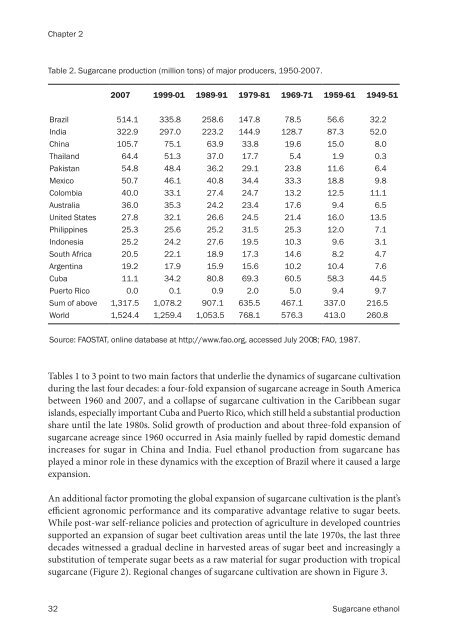Sugarcane ethanol: Contributions to climate change - BAFF
Sugarcane ethanol: Contributions to climate change - BAFF
Sugarcane ethanol: Contributions to climate change - BAFF
Create successful ePaper yourself
Turn your PDF publications into a flip-book with our unique Google optimized e-Paper software.
Chapter 2<br />
Table 2. <strong>Sugarcane</strong> production (million <strong>to</strong>ns) of major producers, 1950-2007.<br />
2007 1999-01 1989-91 1979-81 1969-71 1959-61 1949-51<br />
Brazil 514.1 335.8 258.6 147.8 78.5 56.6 32.2<br />
India 322.9 297.0 223.2 144.9 128.7 87.3 52.0<br />
China 105.7 75.1 63.9 33.8 19.6 15.0 8.0<br />
Thailand 64.4 51.3 37.0 17.7 5.4 1.9 0.3<br />
Pakistan 54.8 48.4 36.2 29.1 23.8 11.6 6.4<br />
Mexico 50.7 46.1 40.8 34.4 33.3 18.8 9.8<br />
Colombia 40.0 33.1 27.4 24.7 13.2 12.5 11.1<br />
Australia 36.0 35.3 24.2 23.4 17.6 9.4 6.5<br />
United States 27.8 32.1 26.6 24.5 21.4 16.0 13.5<br />
Philippines 25.3 25.6 25.2 31.5 25.3 12.0 7.1<br />
Indonesia 25.2 24.2 27.6 19.5 10.3 9.6 3.1<br />
South Africa 20.5 22.1 18.9 17.3 14.6 8.2 4.7<br />
Argentina 19.2 17.9 15.9 15.6 10.2 10.4 7.6<br />
Cuba 11.1 34.2 80.8 69.3 60.5 58.3 44.5<br />
Puer<strong>to</strong> Rico 0.0 0.1 0.9 2.0 5.0 9.4 9.7<br />
Sum of above 1,317.5 1,078.2 907.1 635.5 467.1 337.0 216.5<br />
World 1,524.4 1,259.4 1,053.5 768.1 576.3 413.0 260.8<br />
Source: FAOSTAT, online database at http://www.fao.org, accessed July 2008; FAO, 1987.<br />
Tables 1 <strong>to</strong> 3 point <strong>to</strong> two main fac<strong>to</strong>rs that underlie the dynamics of sugarcane cultivation<br />
during the last four decades: a four-fold expansion of sugarcane acreage in South America<br />
between 1960 and 2007, and a collapse of sugarcane cultivation in the Caribbean sugar<br />
islands, especially important Cuba and Puer<strong>to</strong> Rico, which still held a substantial production<br />
share until the late 1980s. Solid growth of production and about three-fold expansion of<br />
sugarcane acreage since 1960 occurred in Asia mainly fuelled by rapid domestic demand<br />
increases for sugar in China and India. Fuel <strong>ethanol</strong> production from sugarcane has<br />
played a minor role in these dynamics with the exception of Brazil where it caused a large<br />
expansion.<br />
An additional fac<strong>to</strong>r promoting the global expansion of sugarcane cultivation is the plant’s<br />
e�cient agronomic performance and its comparative advantage relative <strong>to</strong> sugar beets.<br />
While post-war self-reliance policies and protection of agriculture in developed countries<br />
supported an expansion of sugar beet cultivation areas until the late 1970s, the last three<br />
decades witnessed a gradual decline in harvested areas of sugar beet and increasingly a<br />
substitution of temperate sugar beets as a raw material for sugar production with tropical<br />
sugarcane (Figure 2). Regional <strong>change</strong>s of sugarcane cultivation are shown in Figure 3.<br />
32 <strong>Sugarcane</strong> <strong>ethanol</strong>












